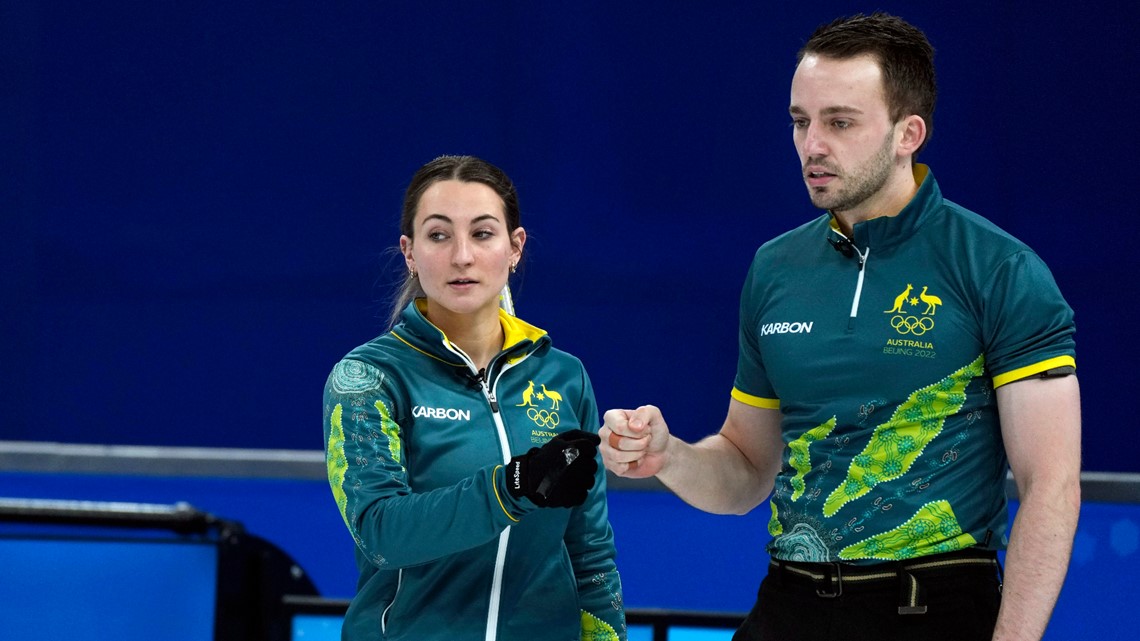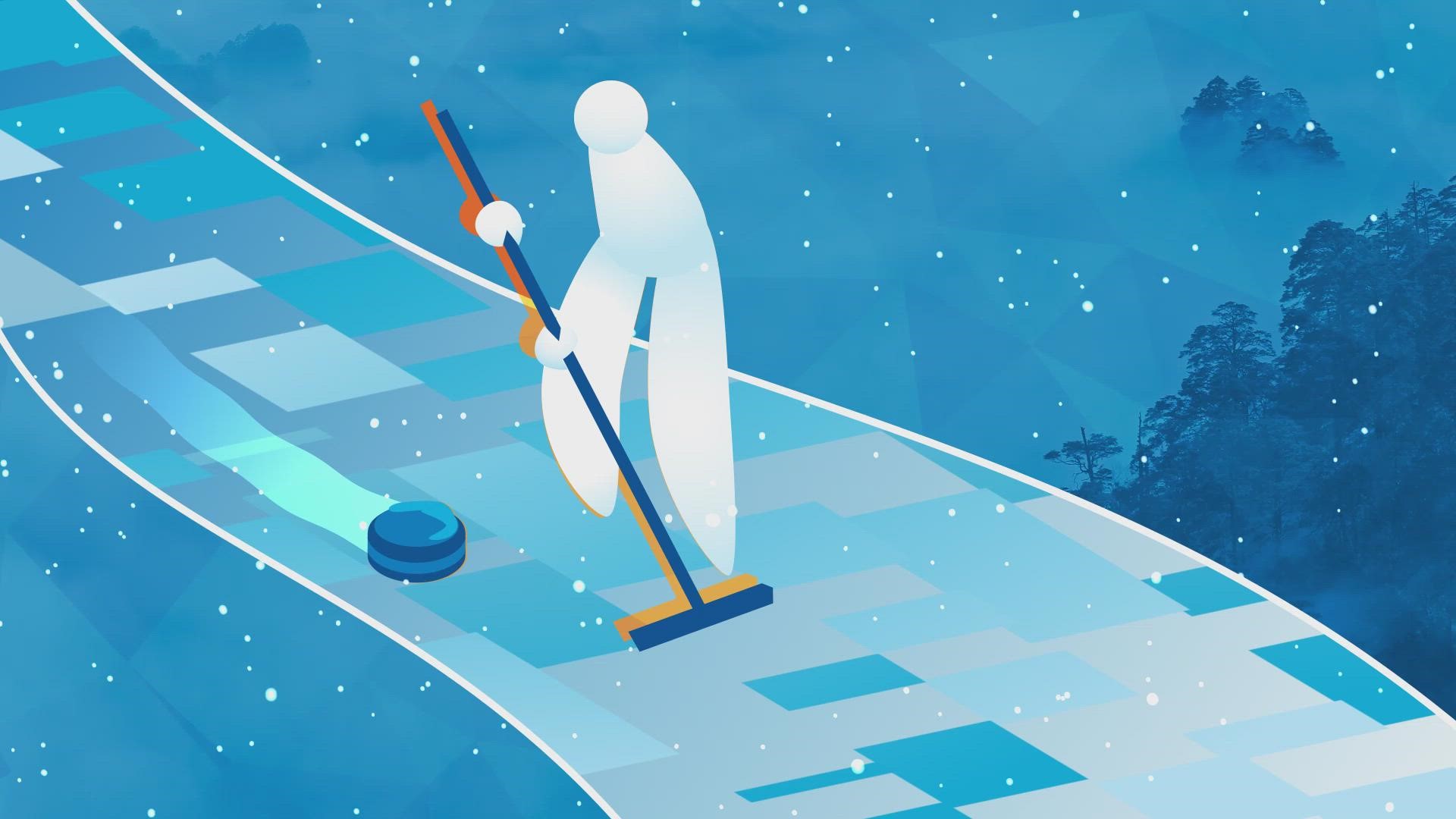After getting a devastating morning phone call that she had tested positive for COVID-19, Tahli Gill and her Australian mixed doubles curling teammate Dean Hewitt were out of the Beijing Olympics.
A few hours later, another call. They were back in.
They barely had enough time to grab their uniforms out of their packed bags — a flight home had been booked for Monday — jump in a cab and get from the Olympic Village to the Ice Cube for a game against Switzerland.
Highlighting a day they’ll never forget, Gill threw the takeout shot that resulted in a three-ender, or three points, that tied the game at 6 in the sixth end. The Aussies won 9-6 for their first victory after opening their first Olympics with seven straight losses.
They fist-bumped Swiss curlers Martin Rios and Jenny Perret, hugged each other and then waved to a spectator who occasionally had yelled, “Aussie, Aussie, Aussie!” in the mostly empty arena.
“You know what? They just experienced the COVID Olympics 101 right there,” said the Aussie duo’s coach, defending mixed doubles gold medalist John Morris of Canada. “I’m sure it was a really tough time for Tahli. I was heartbroken for her when I heard they were out. I’m absolutely ecstatic they’re still playing in this.”


Coincidentally, the Aussies’ final game of the round robin was later Sunday against Morris and his new partner, Rachel Homan.
The Australian Olympic Committee announced late Sunday morning that Gill returned a series of positive tests the night before and that rather than having her go into an isolation hotel, she and Hewitt would be heading home.
But the AOC continued to press her case, and shortly before the scheduled game time of 2:05 p.m., it announced that the medical expert panel examined Gill’s CT values —considered an indicator of how much virus an infected person is carrying — following PCR testing during the previous 24 hours and determined that they fell into an acceptable range. With that, the Aussies were back in.
Gill had COVID-19 before the Olympics and had been allowed to compete under the close contact program, at least until the positive tests late Saturday.
“It’s just been the craziest time,” Gill said. “It was down to the wire, pretty much. The medical team, they were able to review it. I’m so grateful that they put forward a good case. It just shows I’m not infectious.”
After getting cleared to play, it was such a scramble digging through her luggage, literally ripping out clothes to get to her uniform, that Gill grabbed the wrong glove.
“It was really crazy, but I think the fact that we were able to regroup, refocus and pull it off is really cool, and definitely something we’re going to take as a learning development going forward," she said. “It’s just been the most amazing experience.”
Gill and Hewitt were the first Australian curlers to qualify for the Olympics.
“You don’t realize what you’ve got until it’s gone,” Hewitt said. “Once we heard that we actually could play again, it made it extra special for us. Embrace the Olympics, embrace what we had and be grateful for it because it’s something that can be taken away from you at a moment’s notice. We’re so stoked and we can’t wait for our next game as well.”
Rios said the Swiss found out just before getting on the bus to the Ice Cube that Gill had tested positive.
“Now we have two years of experience with the epidemic, so it’s back to unexpected,” he said.
Curlers are known for their camaraderie and sportsmanship. Rios said he was glad the game was played and that they didn’t have to accept a forfeit win.
“We showed up here and there was no official forfeit. I prefer a deserved loss to a forfeit win, to be honest,” Rios said. “They are nice guys and I hope they’re well and can enjoy the rest of this. They’re good curlers. Of course, they were 0-7, but we knew they would give us a hard time on the ice.”
The Swiss had a three-ender in the fourth end for a 4-3 lead but couldn’t hold on.
“They fought back and in the end we were not able to fight back again, and so they deserved to win,” Rios said.
COVID-19 robs Olympic curlers of beloved social culture
Of all of COVID-19’s cruelties, the necessity of distance has caused particular angst throughout the curling community. This is a sport built around closeness, from the pre-game handshakes between opponents, to the post-game drinking sessions, in which the winners typically buy the losers a round. That tradition, dubbed “broomstacking” for the original practice of opponents stacking their brooms in front of a fire after a game and sharing a drink, all but vanished after the coronavirus emerged.
Curling competitions were canceled. Ice rinks where the athletes trained were shut down. And curlers, like much of the world, were forced into isolation.
The Beijing Games are taking place inside an accommodation and transport bubble that is cut off from the rest of the city. The International Olympic Committee’s playbook warns athletes to stay at least 2 meters (6 feet) apart except during competition and to minimize any physical interactions “such as hugs, high-fives and handshakes” — common sights at curling matches. The stakes for slip-ups are huge; those who test positive are sent to quarantine and could miss their event altogether.
Bye-bye, broomstacking.
“All that’s gone away, and that’s a real challenge,” said Hugh Millikin, a vice president with the World Curling Federation. “You touch fists or elbows, but it’s just not the same and it doesn’t necessarily get you that connection with your opposition which is really the cornerstone of what curling’s about. I certainly have worries about how soon we can get back to it.”
On the ice, the coronavirus also forced changes, Millikin said. Training sessions were adjusted to limit the number of sweepers to one at a time, instead of the usual two. While curlers typically cluster around the house — the bullseye-shaped target at the end of the ice sheet — they had to stand apart. And some curling clubs required players to practice in masks, which is difficult given the vigorous sweeping and frequent shouting the game requires, Millikin said.
“When you’re sweeping pretty hard, you’re breathing pretty hard, too,” he said.
The closure of ice rinks forced many curlers to come up with creative training solutions. Two-time Canadian women’s curling champion Kerri Einarson practiced on a homemade rink on Lake Winnipeg, a throwback to curling’s conception 500 years ago on the frozen ponds of Scotland. Einarson’s father and a neighbor cleared a patch of ice on the lake’s surface and drilled in a chunk of wood to serve as a hack, the block that curlers push off from before gliding down the ice.
Pandemic-related store closures meant there was nowhere to buy paint, so they were unable to mark the ice with a target. Still, the experience proved cathartic for Einarson, who struggled with the lack of socializing.
“We couldn’t even celebrate wins with anyone after we were in the bubble,” she said. “It didn’t really feel like winning, which is tough. Even afterwards when you get home, you couldn’t even go and celebrate with your friends and family. It didn’t feel like curling at all.”
For the U.S. Olympic curling teams, the cancellation of crucial competitions was the biggest stressor, said Dean Gemmell, director of curling development at USA Curling. For long stretches, all they could do was practice, and even that was tough. Players from Minnesota and Wisconsin had to travel long distances to find open rinks, on top of juggling their jobs and families.
The teams engaged in scrimmages with each other, but those don’t prepare players for the Olympics the way real competitions do, Gemmell said.
“A big part is just learning how to control your emotions in events that matter,” he said.
Yet despite the yearning many curlers feel for their sport’s beer-sharing days of yore, curling’s social aspect is precisely what makes it so risky during a pandemic. A study last year by Canadian doctors who played in a curling tournament that suffered a COVID outbreak found a key transmission route appeared to have occurred off the ice, at the curlers’ buffet lunches. Of the 18 teams participating, only one team avoided contracting the virus — and that was the team that shunned the lunches and other social events.

